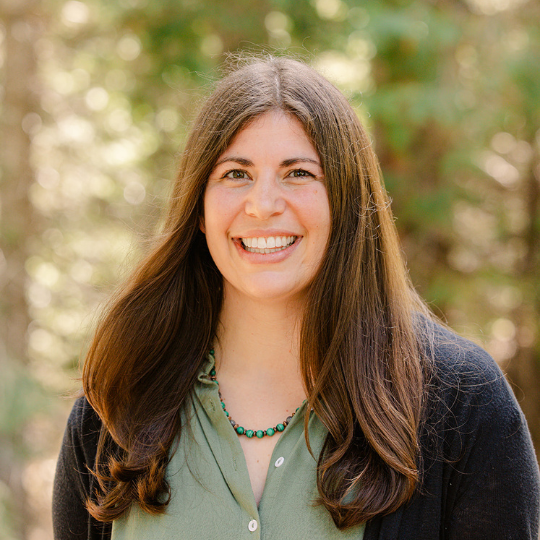Art, Climate and Movement Building: An Interview with Rachel Schragis
Maayan Cohen
|October 21, 2016
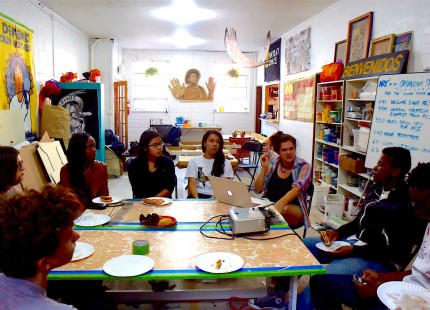
Rachel leading a climate arts workshop with the New York City Action Fellows in 2014
Rachel Schragis is a visual artist, cultural organizer, and lifelong New Yorker, based in Brooklyn. Rachel was the coordinator of the People’s Climate March arts team in which she supported hundreds of creative projects and worked with organizers and artists to develop a narrative framework that weaved together many diverse constituencies and rallying cries to tell a powerful story about the climate movement. I became friends with Rachel through the organizing process for the People’s Climate March (PCM) and have been fortunate to have many opportunities to learn from her and invite her to share her expertise with our New York City Action Fellows.
Rachel’s latest piece, Confronting the Climate: A Flowchart of the People’s Climate March, draws from her experience as an arts and cultural organizer for the march and provides a visual depiction of it’s impact. I am really excited about the opportunities for Rachel’s new piece to serve as a powerful climate education tool and its potential to engage young people in important conversations about the climate change movement.

Rachel and I had the chance to meet up to talk about her latest piece and how it can serve as a dynamic tool for educators and young people to engage in climate change issues and understanding one of the most urgent and complex issues of our time.
MAAYAN: So what is this picture?
RACHEL: In 2014, I was the coordinator of the art team for the People’s Climate March. This image takes that experience and tries to share some of the many things I learned in the process. I got to witness so many different threads of struggle around what it means to confront climate change, and help people come up with visual solutions for how to communicate those struggles.
This image is a map that connects the pictures and stories of people who organized for the People’s Climate March to the biggest questions about what it takes to truly confront climate change. As an artist, my goal is to make seductive images that give people the opportunity to dig deep into the details of the complex issues of our time- that are inspiring without shying away from what’s hard. This image uses the People’s Climate March as an example of what is possible when we are not deterred by complexity. It lays out many unsolvable contradictions about our world, and lifts up the experiences of real people choosing to act in the face of these contradictions. (View a larger version of the image and learn more about it here.)

MAAYAN: What motivates you to share this tool with educators?
RACHEL: I was lucky to have a lot of amazing teachers as a young person, and for my whole childhood, I wanted to be a teacher. It was the way that I saw that I could do something where I was concretely helpful to other people. Previously to becoming an organizer, I worked as visiting artist in public schools in NYC. I taught a class called “Eco Art”, using arts to ask questions about how we approach the material world. When students asked what they could do to solve environmental problems, I struggled with how individualized my answers were: recycle, reuse. It didn’t match my values as an activist committed to collective action. I didn’t feel like I had the tools to open up a conversation about protest in my classroom, and I wonder whether a picture like this that is also in and of itself a work of art could have helped.

So here’s a question: what does it actually look like to be part of a movement? Often I say: you, you having a conversation with your grandpa, you rebuilding your town after a disaster, you starting a sustainable new business- you might not say “I do this because I am part of the climate movement” but that’s exactly what you’re doing. We need to have conversations with young people in school about climate change, and those young people need to know that acting on those hard conversations make them part of a powerful, growing movement. I am such a fan of ACE’s work because I know it tries to make this possible for educators and students, and it’s hard. I think about my last semester of my teaching, during which I was also organizing for the People’s Climate March. Running with my teaching artist bag to a citywide meeting, the world of organizing and the world of teaching couldn’t have felt farther apart. I imagine folding this image out in the center of a circle in my class, how it could have helped bridge the gap.
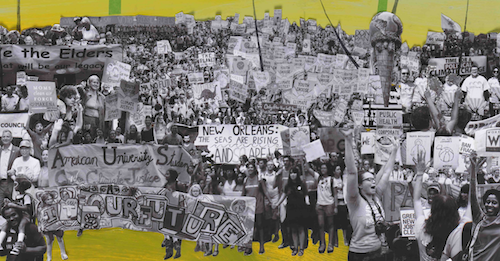
MAAYAN: Why is this a powerful tool for educators and young people?
RACHEL: Some of the most validating moments in my life as an artist have been when I’ve had teachers tell me that they put my images up in their class and it starts great conversation. And this image is the biggest, the most colorful, and I think the most inspiring thing I’ve ever tried to make: it’s a picture of hundreds of thousands of people working together to do something really important and really hard.
As a visual artist whose aims are very pedagogical, I’ve often looked to the visual language of classrooms to help inform my work. I joke that this image is a piece of “hallway art”: it’s 6 feet long and 1.5 feet high. I’d be so curious to see what kinds of conversations would be started just by putting it up in the hallway of a school. This image is all about making connections: between individual people and big ideas, between different parts of the story of what it takes to confront climate change: can young people use this image to help them make the kinds of connections they’re looking to make in school?
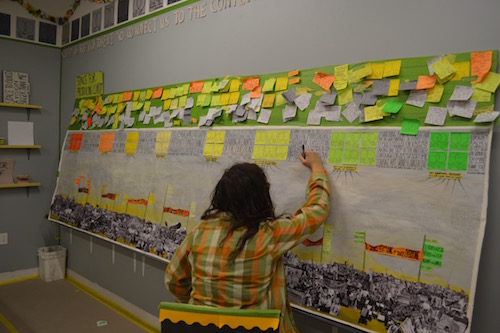
I also have a hunch that this image can help teachers have a kind of conversation about climate change that’s challenging to bring to a classroom: a deeply intersectional, big picture conversation. But actually, you would know the answer to this question much better than I would, Maayan- can I flip the question? Why do you think this is a powerful tool for educators and young people?
MAAYAN: Yes, that really resonates with me! Making climate change feel relevant to young people’s lives is an important component of ACE’s approach to climate education. We educate young people about climate change in a way that puts them at the center of the story and invites them to take action in ways that feel meaningful to them. In my experience, once young people are able to see themselves in the grand story of the climate crisis; able to connect their passions, dreams, and experiences to climate change, they can get to a place where they feel empowered and committed to taking action to do something about it.
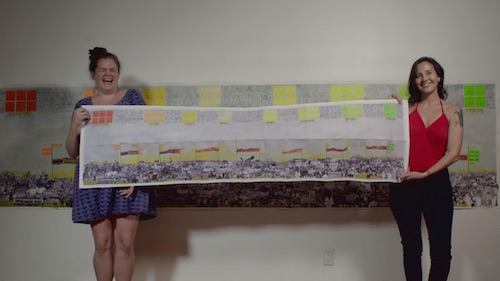
I think this flow chart image shows an incredible visual depiction of the story of the People’s Climate March that reveals both the complexity and challenges in addressing the climate crisis, but also lifts up the power of collective action and the many opportunities for re-imaging a better future. In doing so, this image brings to life the beautiful and important intersectionality present in understanding and addressing this crisis — that climate change is inextricably connected to racial, economic, immigrant, gender, and environmental justice issues, whether through common root causes or through solutions. I think there is a place for everyone to connect deeply with climate change somewhere in this web of intersectional issues. I’ve witnessed what happens when young people begin to see the ways in which their lives and the issues they most care about are so tightly connected to climate justice, they begin to see themselves as main characters in the climate change story and can begin to re-write the narrative with themselves as heroes in creating the kind of future they deserve; one that’s equitable and just with a safe and stable climate.
RACHEL: Wow, that’s so well put. It’s also so overwhelming: there’s so much work educators can and need to do. What’s most exciting to me about sharing this image is that the physical picture has so much packed into it, that it provides many options for how to enter into this complex conversation. I’m really eager to dig in, with both you and other educators, about how to bring this tool to life.
Then, we started brainstorming! We’ve included some bullet points from that conversation below. In the meantime, you can Watch a great video and learn more about the poster on Rachel’s Kickstarter! Preorders end October 28th at 8PM.
Want some ideas of how this could fit in a classroom? Here are some ideas Rachel and Maayan came up with:
- COMPLEXITY: Use this image as an example of how people are working together to address challenges and deal with complex problems.
- CURRENT EVENTS: Understanding the many ways climate change impacts our everyday lives, or cuts through different issues in the world, by using it in current events conversations. You could talk about Hurricane Matthew (and any other extreme weather event) and look at the Hurricane Sandy section. For current event issues that are less clearly connected to climate change, you can frame the exploration as an example of thinking about complex problems. You could ask: How does that problem connect to climate change? Do they have similar root causes? Do they have solutions in common? Who is most impacted by this problem (the same or different communities than climate change)?
- CLIMATE CHANGE: This image helps show the ways we can think about climate change as an intersectional issue. A good place to start is the questions in masking tape, towards the top of the image, that each center around a theme, core question and layer of the climate crisis.
- SOCIAL MOVEMENTS/PROTEST: This image could be used as an example of what a mass protest is. Often our teaching examples are historical (ex: protests during the Civil Rights Movement), and this is an opportunity to explore a current social movement.
- THE CLIMATE MOVEMENT: This image is designed to help people see themselves in the movement. You could ask: where would you stand and what would your sign say?
Join our Youth Action Network
More Blog Posts
Driving India towards self sufficiency and freedom from oil
India can shield itself from oil-price shocks and global pressure over Russian barrels by leaning harder into two strengths it …
Read More
Unnatural, Not Unprecedented
For two weeks, residents of Southern California endured a waking nightmare. Parents raced against time – hurrying down the driveway …
Read MoreCrafting a Vision for the Future: My Experience at LCOY USA 2024
Dry and sunny Tempe, Arizona where temperatures have been over 100 F for 113 consecutive days, delegates gathered to attend …
Read More
